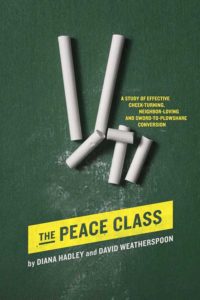The Peace Class: A Study of Effective Cheek-turning, Neighbor-loving and Sword-to-plowshare Conversion
Reviewed by Sandy and Tom Farley
June 1, 2017
 By Diana Hadley and David Weatherspoon. Self-published, 2015. 220 pages. $12.99/paperback; $5.99/eBook.
By Diana Hadley and David Weatherspoon. Self-published, 2015. 220 pages. $12.99/paperback; $5.99/eBook.
Buy from QuakerBooks
Both Diana Hadley and David Weatherspoon write well, and each brings a different background and experience to teaching a semester course in peace studies. The book is not a course outline or curriculum for would-be emulators of their project. What it does offer is a conversation in 38 short essays on the issues explored and the experience of broaching peace topics with college students over several semesters.
Hadley is Quaker and Weatherspoon a Baptist minister, so they both come to peace studies from a Christian perspective. They quickly realized that they needed to remove religious recruitment from their classroom, which opened them to the variety of spiritual experiences of their students. The authors feel that they learned as much if not more than the students.
Hadley and Weatherspoon’s course content included nonviolent communication, the history of nonviolent resistance from Gandhi to contemporary leaders, the uses of the death penalty, “just war” theory, and the “just following orders” excuse among other topics. When the issue was gun ownership, they divided the class by where students grew up. Urban, suburban, and rural childhoods generated different views on this topic.
What the instructors discovered was that many students were not prepared for critical thinking. They were at sea in a class with no right answers, where they were expected to offer opinions and be open to opposing or varying points of view. The class became a course in how to evaluate propaganda and discover the validity that may simultaneously exist in apparently opposing points of view. Anyone teaching these days needs to include these critical thinking skills. (For which we also recommend Eyes Wide Open by Paul Fleischman, reviewed in FJ May 2015.)
Who should read The Peace Class? We doubt that it will be a bestseller or a classic text. Yet anyone venturing into teaching a high school or college level class in history, social science, politics, peace, or nonviolence would find it useful. Many of the short essays could easily spark discussions at a meeting retreat or adult study session.



Comments on Friendsjournal.org may be used in the Forum of the print magazine and may be edited for length and clarity.